Even as the least populous state in America (with fewer than 600,000 people), Wyoming commands an outsize hold on the country’s—and the world’s imagination.
William “Buffalo Bill” Cody’s Wild West shows exported the idea of the Old West to the rest of the globe. The otherworldly landscapes of Yellowstone spurred the creation of the U.S. National Park Service. The Equality State, as it’s officially known, even pioneered women’s suffrage 50 years before the passage of the 19th Amendment. This is a land of extremes, where the Great Plains meet the Rocky Mountains, where a calm lake belies the magma of a supervolcano bubbling beneath, where a fur-trappers’ frontier town can evolve into a getaway for the global elite. From the peaks of the Tetons to the wide open sky, everything in Wyoming is larger than life—and traveling here will make you feel the same way.
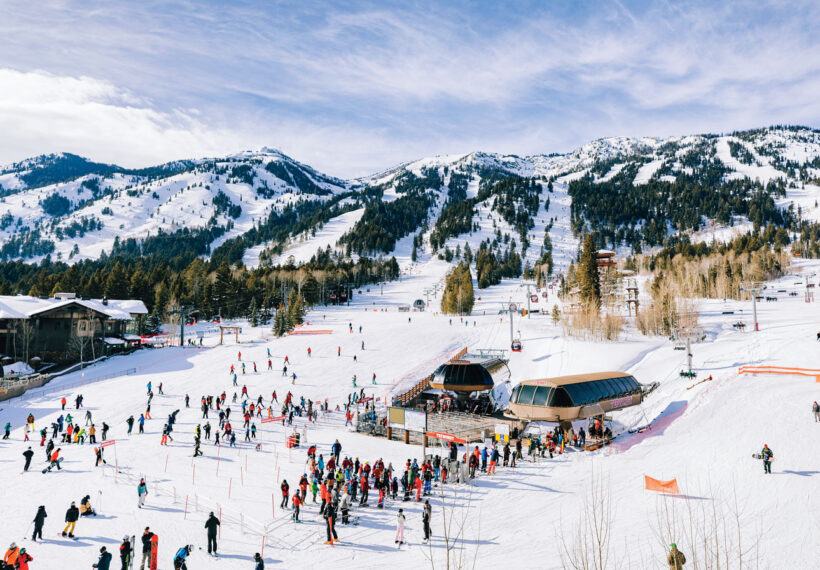
Day 1
“Cowboy powder,” waffles at 10,000 feet, and America’s scariest ski run
I begin my first morning in Wyoming gazing out the window of Big Red, the aerial tram at Jackson Hole Mountain Resort (JHMR), as it zooms toward the peak of Rendezvous Mountain. Led Zeppelin is blasting and excited chatter fills the car in the mere nine minutes it takes us to ascend 4,139 vertical feet. My mom and I clutch our skis, excited to hit the slopes but not quite ready for the cold. “You’re going to want to put your goggles back on when we go outside,” our ski instructor, Sloane Bergien, warns us.
As soon as we leave the tram, the wind attacks, thrashing us with snow. Luckily, a hot breakfast awaits inside Corbet’s Cabin, a 1966 ski patrol hut that for the last decade has doubled as a waffle shack. An order gets you two waffles with your chosen topping sandwiched in between, wrapped in foil for easy on-mountain transport. Either it’s the elevation (10,450 feet) or the copious brown sugar and butter, but I’ve never had a better waffle.
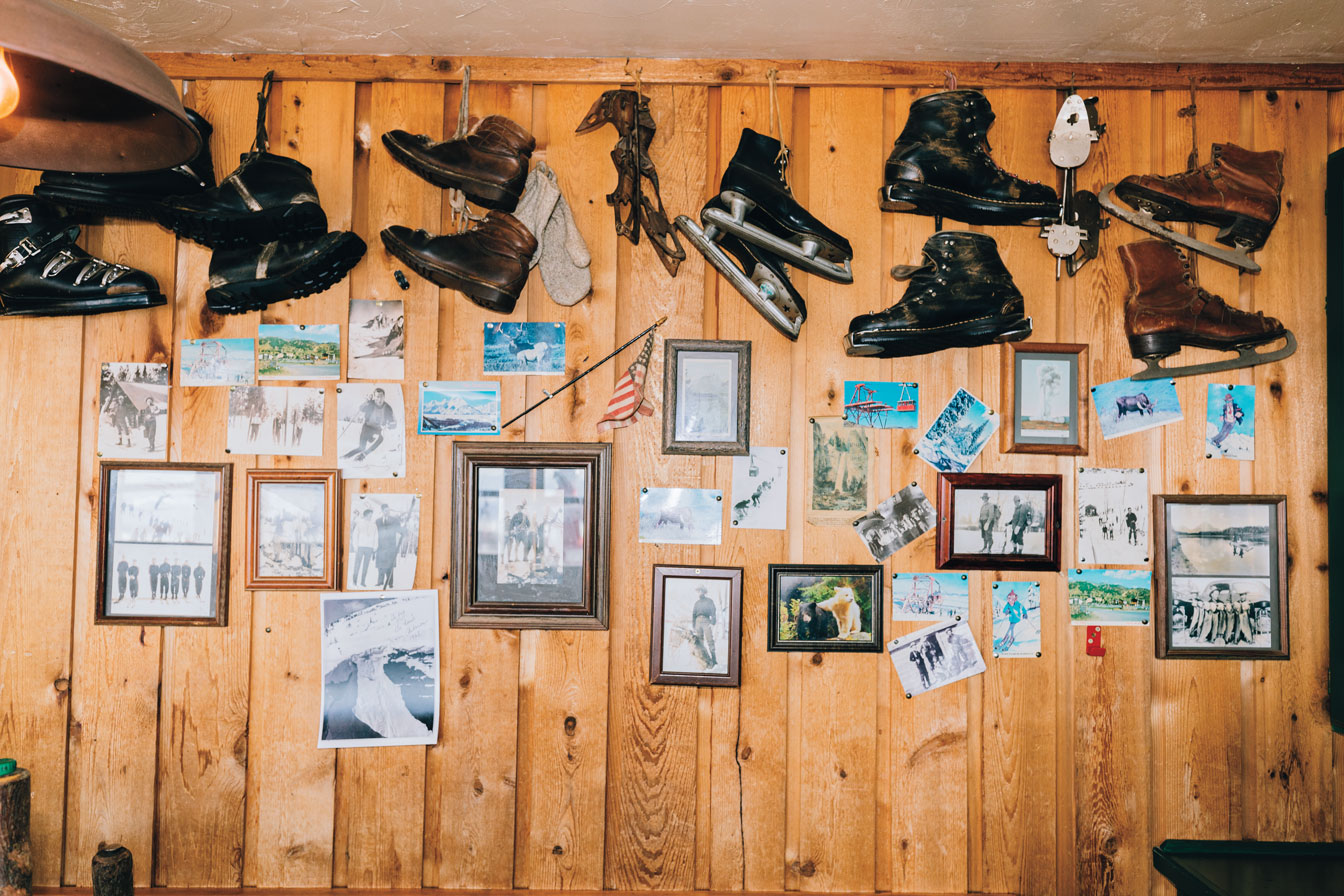
With its wood paneling, retro resort memorabilia, and steamed-up windows, the cabin is a cozy vantage point for watching intrepid skiers psych themselves up for the infamous Corbet’s Couloir: a 10-foot-wide chute with a 10- to 20-foot free fall that’s known as “America’s scariest ski run.” The run and cabin take their name from mountain guide Barry Corbet, who, upon spotting the couloir in 1960, famously predicted that “someday someone will ski that.”
That someone is not me. Instead, Mom and I click into our skis and let the wind nudge us into the black-diamond Rendezvous Bowl. With every turn through the wide-open basin, I feel as if I could soar out into the valley.
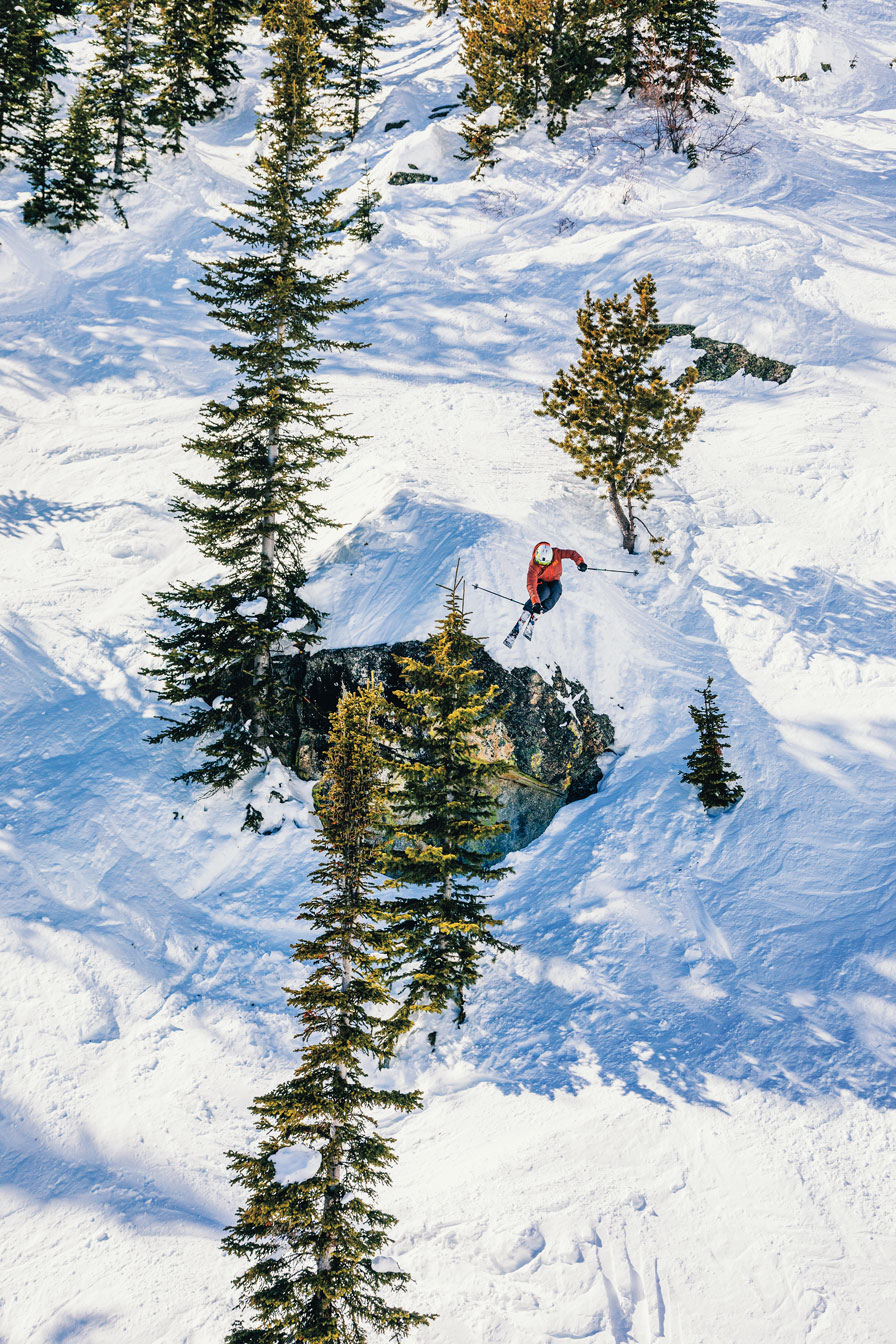
Independently owned since it was opened by two ski buddies in 1965, JHMR is unique among North American ski mountains, which are continually being gobbled up by conglomerates. With half of its terrain classified as “expert,” it’s one of America’s most technically advanced mountains (and, with a full day lift ticket clocking in at $170, one of the priciest). Recently, though, the mountain has focused on growing its appeal among more casual skiers and their families, opening the Sweetwater Gondola to provide easier access to intermediate and beginner trails, and Solitude Station, a 12,000-square-foot learning center for kids 7 and up.
My mom and I are both lifelong skiers, however, and we’re here to push ourselves. Bergien is happy to comply, leading us down a series of bump-filled expert runs, including North Colter Ridge and Cirque, where we pause to gaze up at Corbet’s Couloir with fear and admiration. “Skiing is like boxing,” she tells us, as we stop to catch our breath, pressing our edges in snow that’s thickening as the day warms up. (Locals call it “cowboy powder.”) “You’re trying to stay upright and getting punched from every side.”
By lunchtime our legs are burning, so we duck into Piste Mountain Bistro, at the top of the Bridger Mountain Gondola. The restaurant has all the hallmarks of fine dining, including table service and a menu of primarily locally sourced ingredients except that the patrons are all clomping around in ski and snowboard boots. We feast on flaky cheddar biscuits, a winter vegetable salad with ricotta and candied oranges, and fried chicken with maple-bacon-glazed brussels sprouts. It’s a far cry from the soggy fries and questionable chili served at the ski lodges of my youth.
For our last few runs, we stick to gentler groomed trails, and Bergien eventually guides us down to the Four Seasons Resort and Residences Jackson Hole. After the hotel’s ski concierge stows our gear and removes our boots for us (now, that’s service!), we drag our weary bodies through Teton Village for a beer at the Mangy Moose. This bar kick-started the mountain’s après scene in 1967, and it has since hosted an eclectic array of musical acts, from Blues Traveler to Coolio. We sip a couple of Mangy Moose Brews—an amber ale made by Idaho’s Grand Teton Brewing—beneath a taxidermy moose pulling a sleigh, and relive our favorite runs of the day.
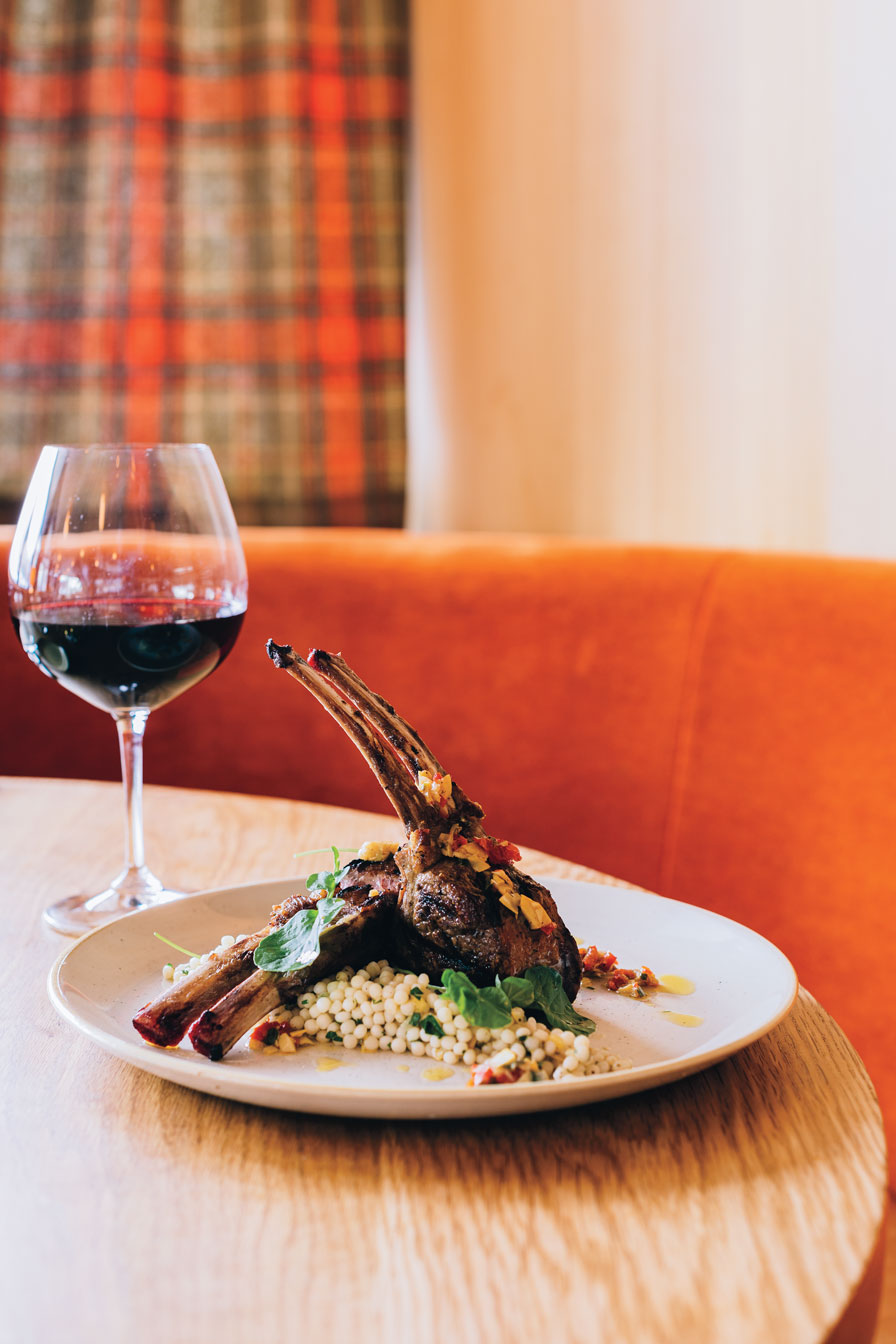
Dinner is at the restaurant inside Caldera House, Teton Village’s newest luxury hotel, which offers eight apartment-size suites and its own members-only ski club. Mom and I split creamy burrata, a fig-and-prosciutto pizza, perfectly charred lamb chops, and a piece of cheesecake made with housemade mascarpone and ricotta, as light and fluffy as the snow falling outside. As we trudge back to our cozy fireplace at the Four Seasons, we can hear the faint explosions of avalanche tests on the mountain—the ski patrol preparing for tomorrow’s first tracks. You might say our first day is ending with a bang.
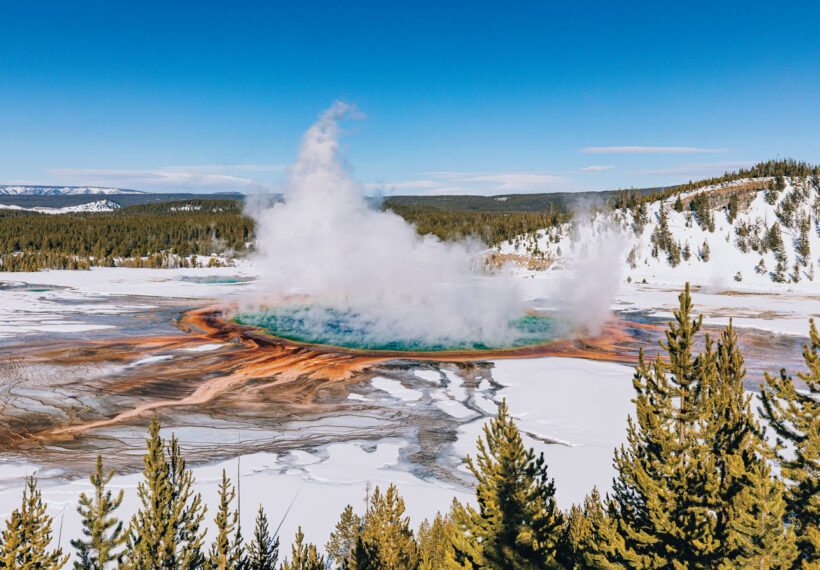
Day 2
Fields of elk, wildlife on canvas, and sushi in a blacksmith shop
We wake up sore, so we decide to give our legs a rest and spend the day exploring the town of Jackson. (Jackson Hole, I learn, refers to the entire 60-mile-long valley, which formed along the Teton fault 10 million years ago.) We drive 20 minutes south and drop our bags in town at the rustic-chic Anvil Hotel.
After a short walk through the elk-antler arches of Jackson Town Square, we arrive at the 19th-century bungalow that’s home to Persephone Bakery, where we split a perfectly flaky, buttery kouign-amann and a skillet of black-pepper scones drowned in red-eye gravy. Maybe we should get on the slopes today after all.
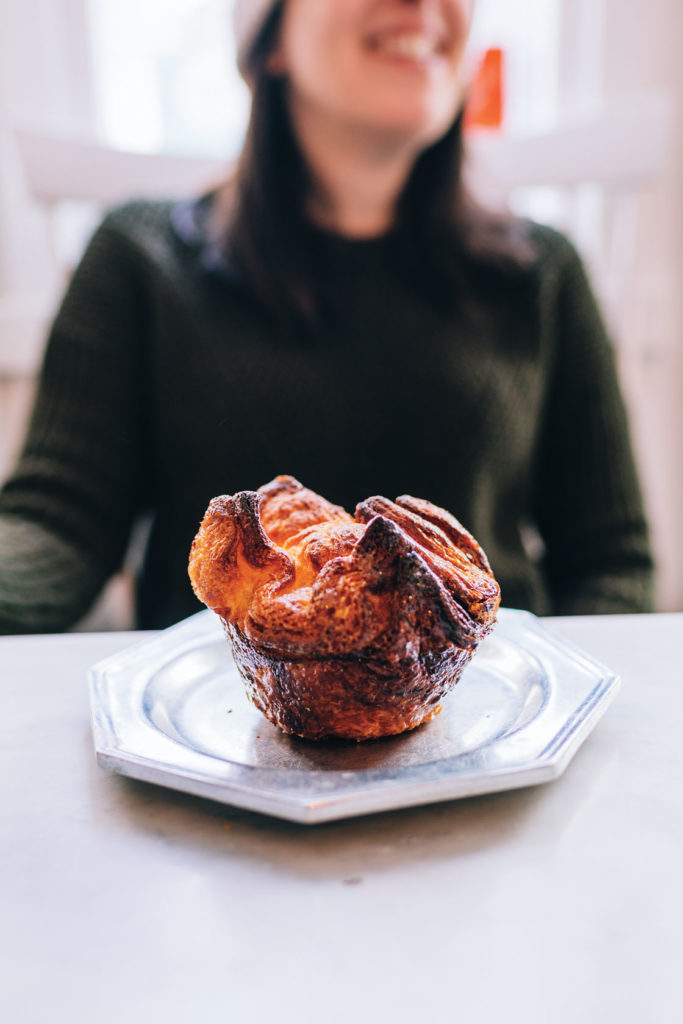
Instead, we drive a mile east to the Jackson Hole & Greater Yellowstone Visitor Center to check in for a sleigh ride through the National Elk Refuge, where the largest migrating herd in North America spends the winter. We hop into a bright red sleigh and bundle up under wool blankets as our guide, Lynn, introduces us to the 2,000-pound Percheron draft horses, Jet and Jeff, who will be transporting us. The sleigh groans and clanks as we pull out into the snowy expanse of the 24,700-acre refuge. “It’s just like ‘Jingle Bells!’” Mom chirps.
Lynn explains that in 1912, Congress set aside money to purchase the land, eventually buying it from 34 homesteaders to create a protected winter habitat for the herd after thousands of elk had starved over the course of several harsh winters. “The elk were here first,” he says, “before white men ever found this valley.” Today, the preserve draws between 5,000 and 8,000 elk, which travel from as far as Yellowstone, about 60 miles north. The population in the park is dwindling, Lynn explains, in part because they’re increasingly being hunted by grizzly bears, since the bears’ main food source, cutthroat trout, is being eaten by a non-native lake trout. “You can see the ripple effect that happens when a non-native species is introduced,” he says. “It’s a lot more complex than people realize.” He pulls the sleigh alongside a few elk that are lying in the snow, apparently unbothered by our presence. I’m struck by their quiet majesty, the jagged peaks of their antlers echoing those of the mountains behind them.
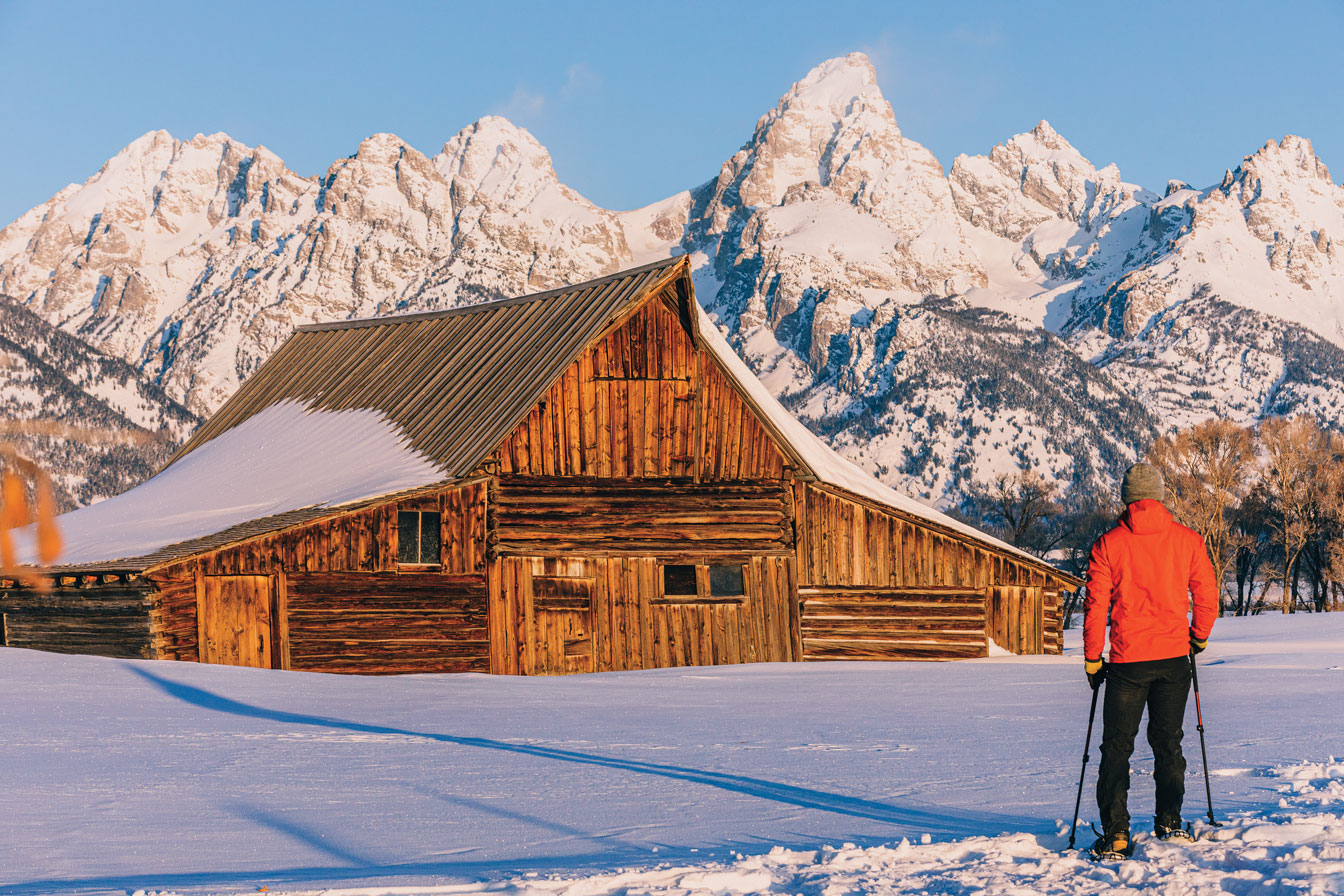
After the tour, we drive five minutes to the National Museum of Wildlife Art, which appears as a jagged stone facade tucked into the hillside. The collection inside spans from 2500 BCE to today and represents more than 550 artists, creating a kaleidoscopic survey of humanity’s enduring fascination with animals. “Everyone’s like, ‘Why does this museum in a Wyoming mountain town have a Rousseau, an O’Keeffe, a Warhol? ’” says marketing director Allie Tscheulin, as she guides us through the galleries. I’m drawn to a selection of 16 landscape studies by Carl Rungius, a late-19th century German immigrant who became known as the “Monet of the Mountains.” Each of the works—tiny Impressionistic renderings of craggy peaks, cool mountain lakes, and tall, dark pines—embodies the discipline that so many of the artists on display here devoted to capturing the wildness of the west.
After enjoying bison gyros, Snake River Brewing lagers, and views of the elk refuge at Palate, the museum’s in-house restaurant, we drive back into town for a little shopping. Jackson is the kind of place where you can peruse high-end boutiques, stroll through galleries filled with pieces by internationally known contemporary artists, and then two-step at a century-old saloon. We look at chef’s knives etched with the outline of the Tetons at New West Knife Works and try on bison-fur coats and hats (available with and without horns) at Mtn Man Toy Shop. Inside the antiques-filled home goods shop Mountain Dandy Showroom, I overhear a woman in a white fur jacket complain to the sales clerk, “It’s so hard to buy for people who have everything.”
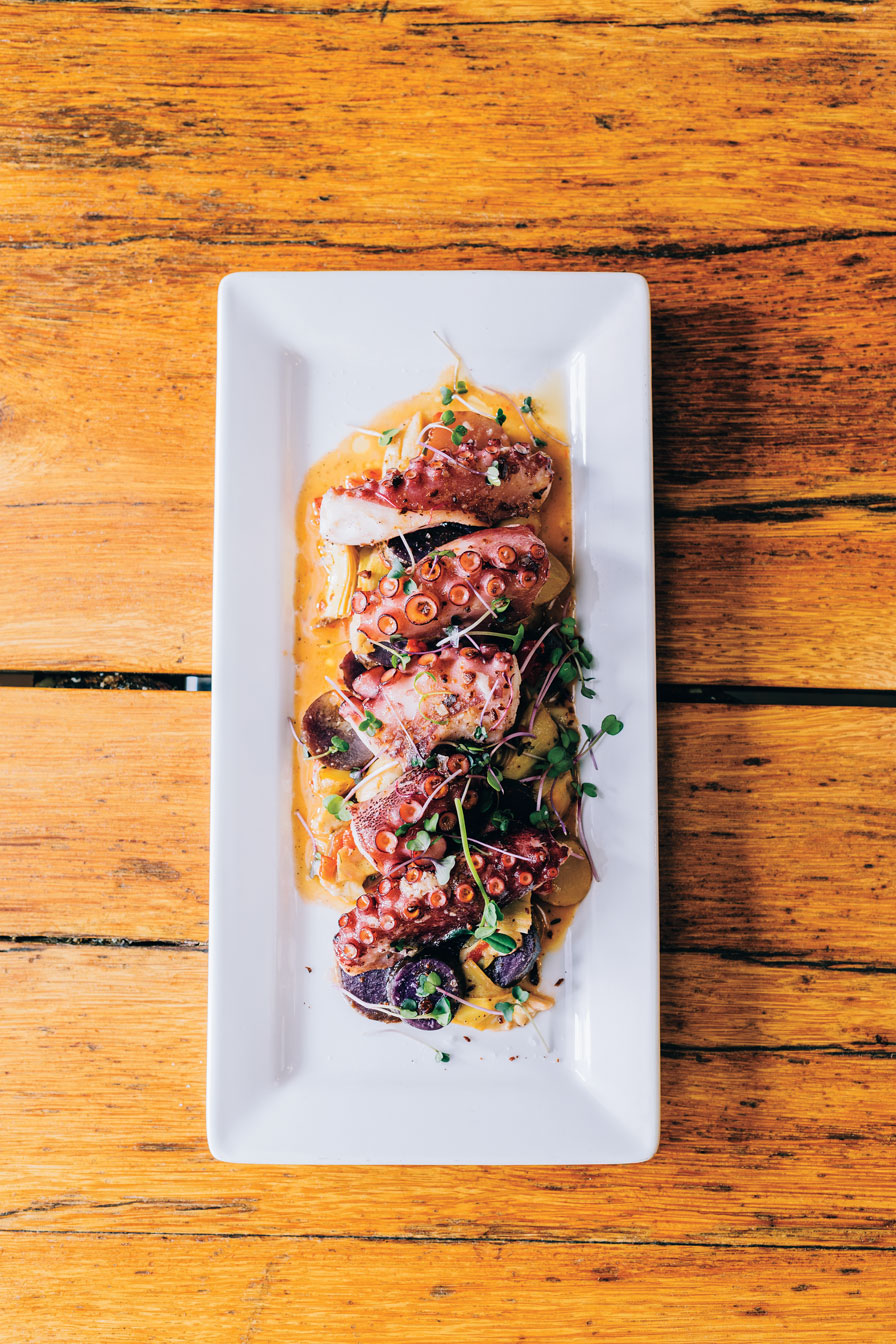
It’s growing dark, and a glass of wine sounds appealing, so we walk two blocks to Bin22, a wine shop and tapas bar where we’re greeted by owner Gavin Fine. With his shaggy hair, colorful Vans sneakers, and roguish smile, Fine gives off a ski-bum vibe, but he’s no slouch. With a culinary empire that includes six restaurants between Jackson and Teton Village, plus a craft butcher and an ice cream company, Fine has redefined the area’s dining scene over the past two decades. “I noticed there was this new clientele coming in from New York, San Francisco,” he says. “They wanted to be rustic, do all the cowboy stuff, but at the end of the day they wanted a nice bed, good wine, a nice cocktail.”
He recalls how when he first came to Jackson you could order fish at restaurants only on Tuesdays and Thursdays, when the seafood delivery arrived. Now a FedEx plane lands daily, bringing hamachi from Japan, mussels from Seattle, and tuna from Hawaii to Fine’s restaurants.
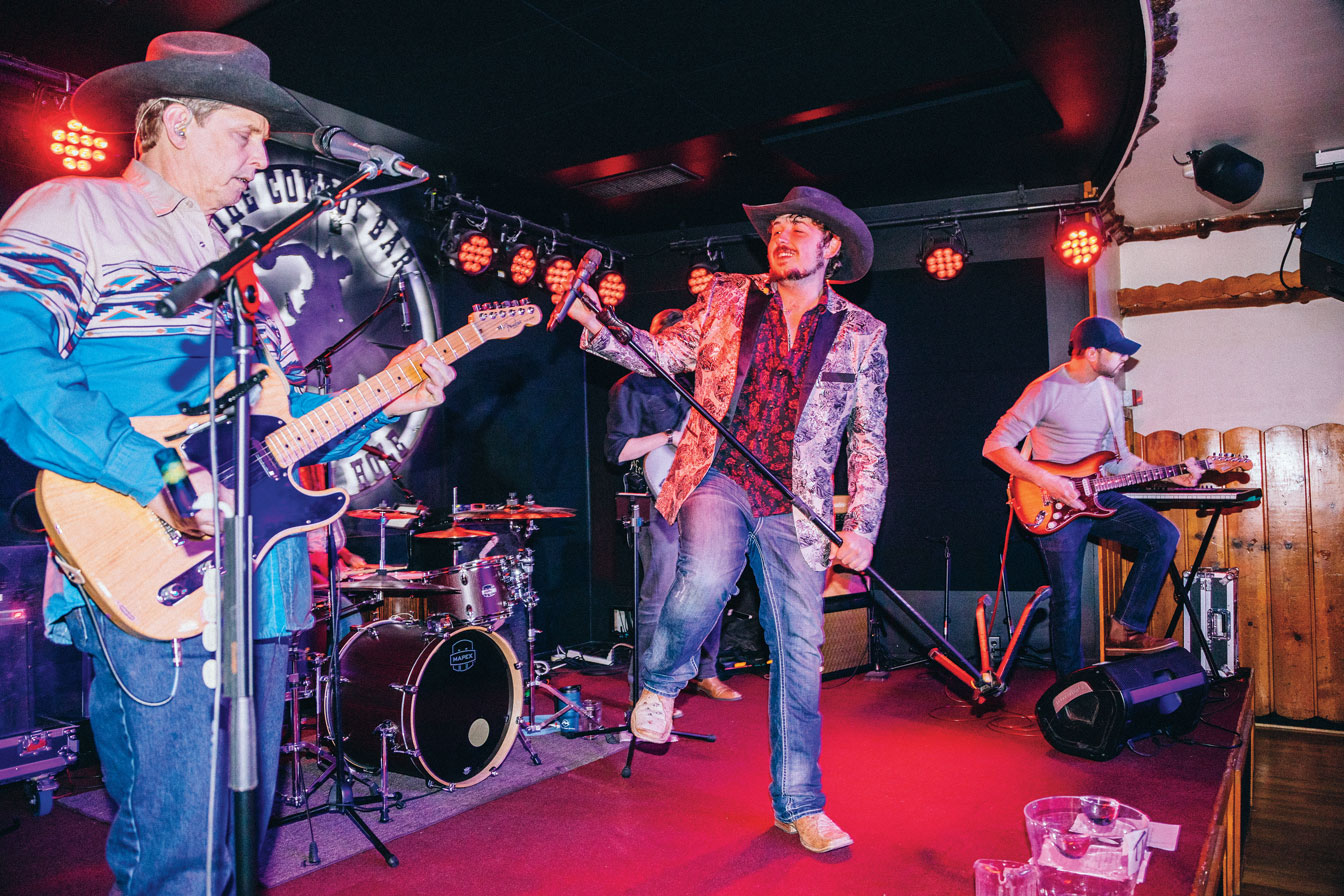
We can’t leave without sampling some of the tapas—charred octopus with artichoke hearts, shrimp in a garlicky blistered-tomato sauce—but we’re careful not to eat too much, because we have another round of seafood planned at King Sushi, which serves sushi and sashimi in a 110-year-old building that once housed a blacksmith shop. Mom is skeptical: “Sushi? In a log cabin? In Wyoming? ” But she warms to the idea once we’re settled in with pink snapper nigiri, Kusshi and Beau Soleil oysters, and a Hidden Dragon roll (soft-shell crab, spicy salmon, and seared scallop, topped with yuzu tobiko).
On our way back to the Anvil, we succumb to the neon glow of the Million Dollar Cowboy Bar’s bucking bronco sign, which flashes from across the town square like a beacon. We climb onto saddle stools at the bar, which is embedded with silver dollars. The first place in the state to receive an official liquor license after Prohibition, this saloon gets its name not from those coins (there are only 624 of them, the bartender tells us), but from the cost of renovations after a fire decades ago. As we wait for our Miller High Lifes, Mom grabs the saddle horn, leans back, and lets out a “Yeehaw!” In the back, a band plays Old Crow Medicine Show’s “Wagon Wheel” as a few couples sway on the dance floor. “Come on, you’ve got boots on!” the singer urges everyone in the bar. I can’t help but give in to his call.
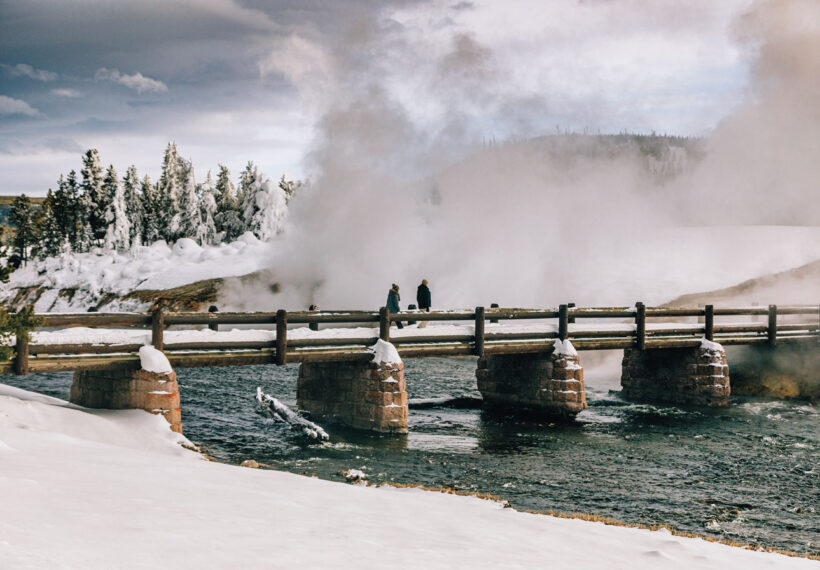
Day 3
Erupting geysers, baby bison, and a hidden supervolcano
It’s just after sunrise, and Mom and I are gently jostling along snowy roads through the southern Flagg Ranch entrance of Yellowstone National Park. From inside our Scenic Safaris snowcoach—an SUV like vehicle with giant low-pressure tires, it’s the only wintertime transport here, apart from snowmobiles—the park seems untouched, Narnia-like, except for some stray rabbit tracks by the side of the road. We let the rocking movement of the drive lull us into a brief nap, and by the time I open my eyes we’re pulling into the Old Faithful Snow Lodge & Cabins.
True to its name, the Snow Lodge overlooks Old Faithful, the world’s most famous and predictable geyser, with about 20 daily eruptions that can be timed with close to 90 percent accuracy. (The geothermal phenomenon was named by members of the 1870 Washburn-Langford Doane Expedition, one of three missions into the area that influenced Congress to make Yellowstone America’s first national park in 1872.) As we check into the hotel, we notice eruption countdown announcements posted in the lobby. The next one is due in 10 minutes, so we drop our bags, layer up, and head out into the cold. The rows of benches encircling the geyser, usually packed during the peak summer season, are mostly empty. The hot spring begins to spit and sputter, then plumes of steam and thousands of gallons of 200-degree water build until they’re shooting nearly 130 feet in the air.
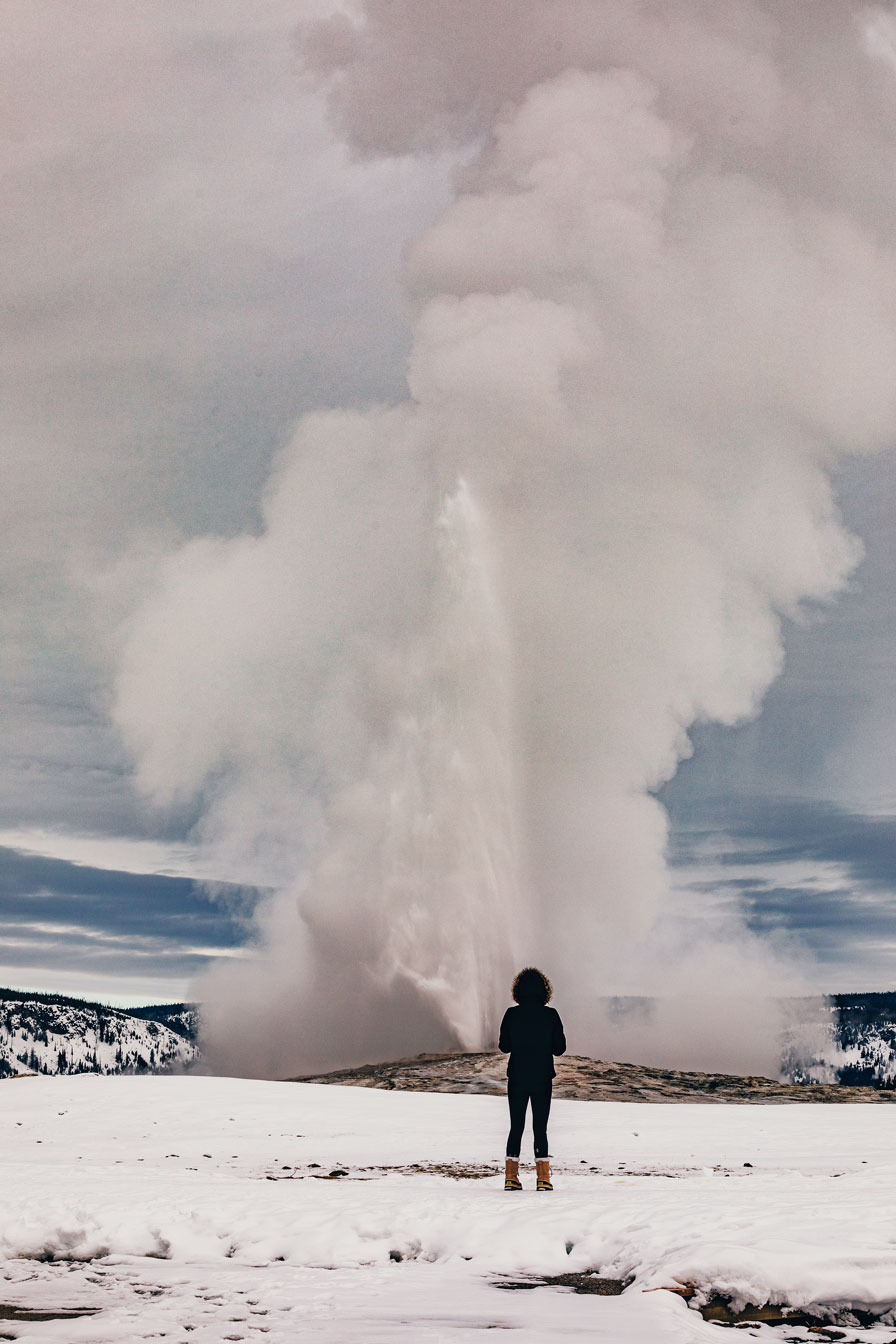
Once the eruption has settled, we head for the boardwalks of the Upper Geyser Basin, an area that has the largest concentration of geysers anywhere in the world, with at least 150 in one square mile. All the hydrothermal activity is due to the park’s location atop one of the planet’s largest active volcanoes, which had its last major eruption 640,000 years ago and once spewed ash as far east as Missouri. The magma that fueled that volcano now powers hot springs, mud pots, fumaroles, and geysers throughout the park. The indigenous Kiowa people’s origin myth is set in “the place of hot water,” and their ancestors, along with the Blackfeet, Shoshone, and Nez Perce tribes, used thermal waters for religious and medicinal purposes for thousands of years.
We can’t walk more than a few feet along the boardwalk without stopping to marvel at a different feature: the dramatic gurgling of the aptly named Teakettle Spring; the 4-foot-tall cone of Beehive Geyser, which acts as a nozzle during eruptions, pushing the water as high as 130 feet; the vivid ocher, green, and yellow bacterial mats that form around the hot springs’ edges, where microorganisms thrive in the extreme heat. We lean over the springs to feel a bit of the hot steam on our faces, ignoring the sulfur smell.
After a lunch of bison chili back at the Snow Lodge, we’re ready for our next activity, a wildlife tour along the Madison River. Our guide, Emily, loads our group into another snowcoach, and we set off along the Firehole River, which meets the Madison about 17 miles downstream. Ten minutes into the drive, we spot a herd of about 30 bison in a meadow. Emily is full of bison facts: These are calves and cows, as male bison usually travel alone; the reddish fur on the younger calves, or “red dogs,” indicates that they were born late in the spring calving season; and during winter, bison spend about nine to 11 hours every day burrowing in the snow for grasses to eat, using their head like a plow. (Their hump is actually a large muscle developed for plowing.) “One famous park naturalist’s analogy was that in summer, bison eat cereal,” she says. “In winter, they eat the cereal box.” Yellowstone is the only place in America where these creatures have lived continuously since prehistoric times, and the herd now numbering as high as 5,500—is one of the last “pristine” herds in the country, meaning they haven’t been bred with cattle.
As we arrive at the river junction, a tawny coyote trots in front of the snowcoach, pausing in the middle of the road as if it’s posing for us. “It’s the pet coyote they let out for us,” Mom jokes.
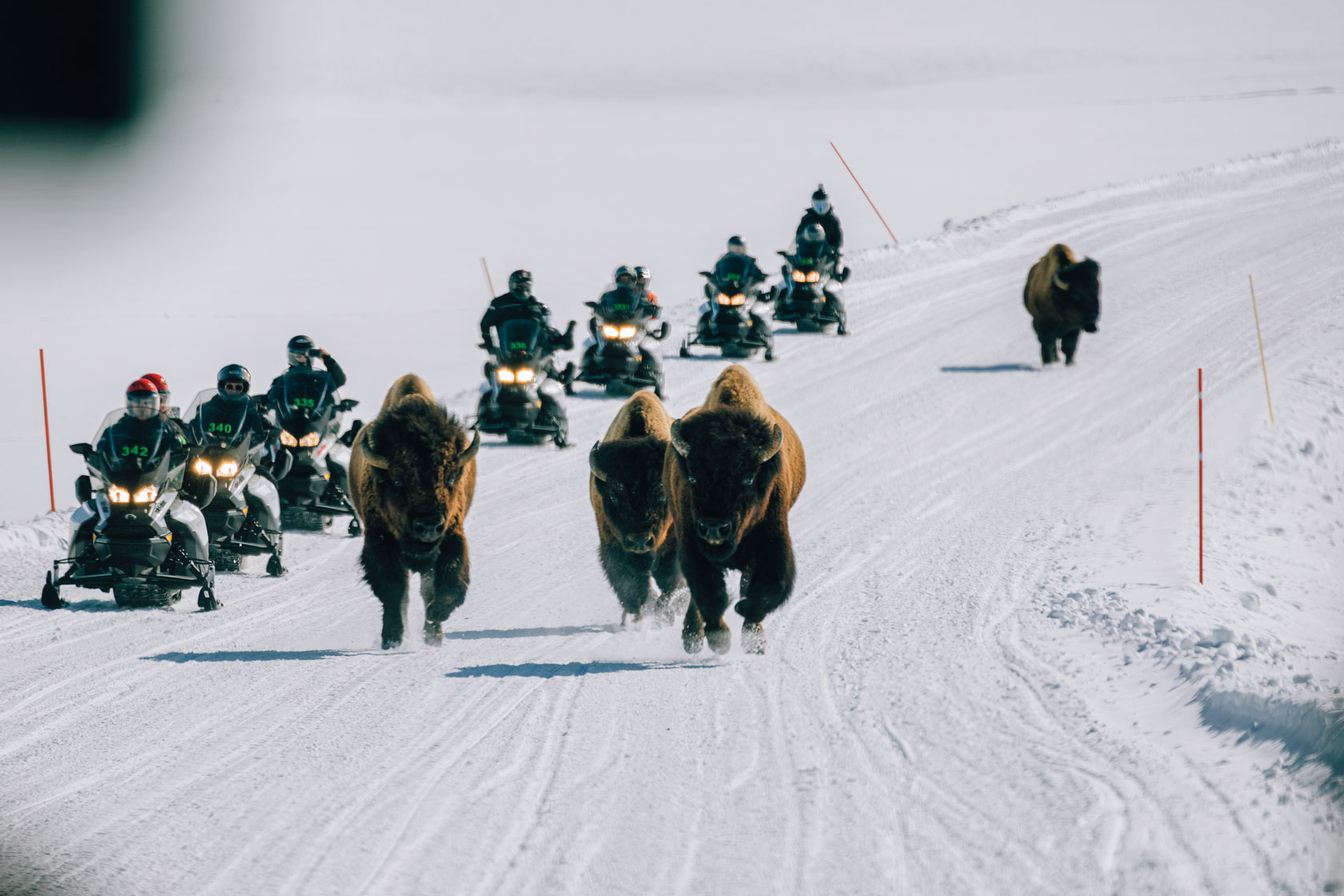
I’m hoping to spot a gray wolf—they were reintroduced to the park in the 1990s, and now more than 500 of them live in the area’s greater ecosystem—but no luck. Instead, we see pairs of trumpeter swans and black and white Barrow’s goldeneye ducks bobbing in the Madison River. A sprightly coyote pounces on something in the snow. And on the way back to the Snow Lodge, we’re stopped by another group of bison blocking the road. Emily slowly inches the snowcoach forward, and the bison begin to disperse, although Mom manages to snap a photo of one staring menacingly through the coach windows.
We freshen up in our room at the Snow Lodge and then head down to the hotel bar, the Firehole Lounge, for an aperitif. The menu is surprisingly varied, considering this place is currently inaccessible by car. I order the Married Moonshine Hot Toddy, made with Milk Can Cinnamon Moonshine from Casper, Wyoming, while mom goes for the Huckleberry Margarita.
Dinner is just next door, in the Obsidian Dining Room. Over plates of wild game Bolognese and bison short ribs slow-cooked in Montana-brewed Moose Drool ale, we page through the photos on our iPhones, trying to see whether any of the magic we saw that day translates to our tiny screens. After a couple of glasses of cabernet, we decide to go back out into the cold and look at the stars, maybe even wait to see Old Faithful blow one more time.
The wind is crisp and light, and a few intrepid guests are out on the neon-lit skating rink. It’s cloudy overhead, but seeing the steam rise from the geysers, the depth of the darkness beyond the warm lights of the lodge, the dark shadows of spruce and lodgepole pines, I still feel small, in the way that you do under a sky full of bright stars, in the midst of a wild and unforgiving landscape.




